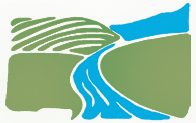Are you ready? The 2025 Wayne County Envirothon will be held at the Montezuma Audubon Center on Thursday April 27th. Envirothon is an annual competition in which teams compete by demonstrating their knowledge of environmental science and natural resource management. Teams, each consisting of five students from schools, home study groups and environmental clubs, exercise their training and problem-solving skills in a competition centered on five testing categories: Soils/Land Use, Aquatic Ecology, Forestry, Wildlife, and Current Environmental Issues.
Water Quality Updates: Summer 2022
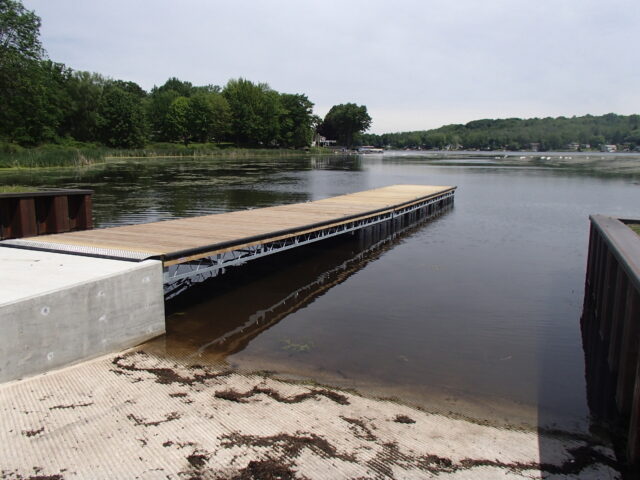
New York State Fishing Access Site’s new floating dock system at Port Bay South, June 2022
Water Quality continues to be a concern due to changing weather, and temperatures, through watershed management. Throughout the summer of 2022 until Columbus Day, District staff will be reviewing water quality and positing updates if there are specific concerns on the waterfronts and how to manage them throughout Wayne County. Watersheds are the entire area that supplies water to a waterbody. This can potentially make up 1000s of acres of land with various topography, and use. Water quality update reports will include descriptions based on weather patterns, temperature, what you are seeing in the water, invasive species and local water quality projects.
The District monitors water quality across Wayne County throughout the year and tried to address targeted issues that have been brought up by the communities. One of the positives from the COVID response was the District’s Landowner Assistance Program (LAP forms) and Municipal Assistance Program (MAP forms) that are available online to help target and narrow down issues. This form is fillable and allows the landowner or municipal leader to upload a request and photos in real time from our Website.
This report allows us to see where review is needed. The LAP/MAP program is for technical review by trained technicians. It is not a grant program. The District staff will review the site through technical maps, permitting needs and water quality considerations and then will follow up with the requestor by email or by phone depending on the initial review findings. On a rare case, there may be a request for an on-site visit. This process may take 2-3 weeks depending on the amount of requests that come in at once.
The District’s Technical Staff is made up of 5 people that have made community water quality their professional career. They focus on the “bigger picture” of watershed management while working to address the water quality impacts of the local community.
Aquatic Vegetation Control aka Weed harvesting Summer 2022
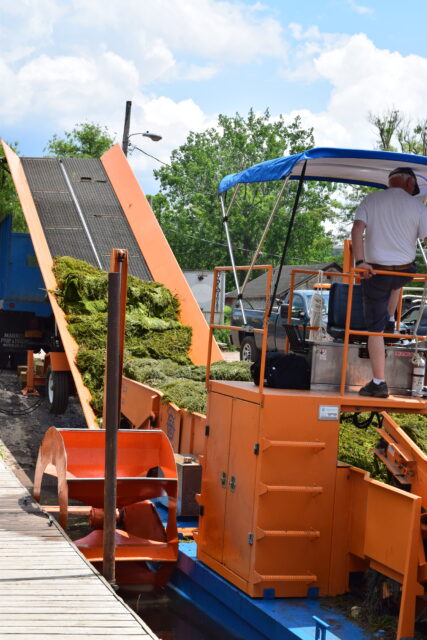 Aquatic Vegetation Control (AVC) is a form of nutrient management that is one of several management techniques used to manage non-point source water pollution that is natural but also impacts a balanced ecosystem for water quality. Selective harvesting invasive species and some high concentrations of water weeds verses letting them die off and fertilize seedbeds within a waterbody does three things for the environment:
Aquatic Vegetation Control (AVC) is a form of nutrient management that is one of several management techniques used to manage non-point source water pollution that is natural but also impacts a balanced ecosystem for water quality. Selective harvesting invasive species and some high concentrations of water weeds verses letting them die off and fertilize seedbeds within a waterbody does three things for the environment:
-
-
- Removes nutrients from waterbody in specific areas to prevent high growth of stronger weeds;
-
- Reduces the potential for continuous spread of some highly invasive aquatic weeds like Water Chestnut;
- Increases flow from the outlets of streams into the waterbody to allow for regular movement of water thus preventing algal blooms.
There are other benefits to this management technique which include pathways for boaters to navigate into open waters, pathways for fisherman to access weed-beds for better fishing and better ascetics for the community. The District’s Aquatic Vegetation Control program subcontracted by Wayne County, began on June 13th and will provide 1 service to specific areas in 2022 through September 9th. The tentative schedule has been posted but is subject to change based on technical review weekly by the staff for addressing water quality impairments. Further schedule updates can be found on the District’s website.
For additional information on Invasive Species Management and the Aquatic Vegetation Control program please go to visit the AVC Program Webpage
Water Quality Update: 8/4/2022 Lake Ontario & Seasonal Change
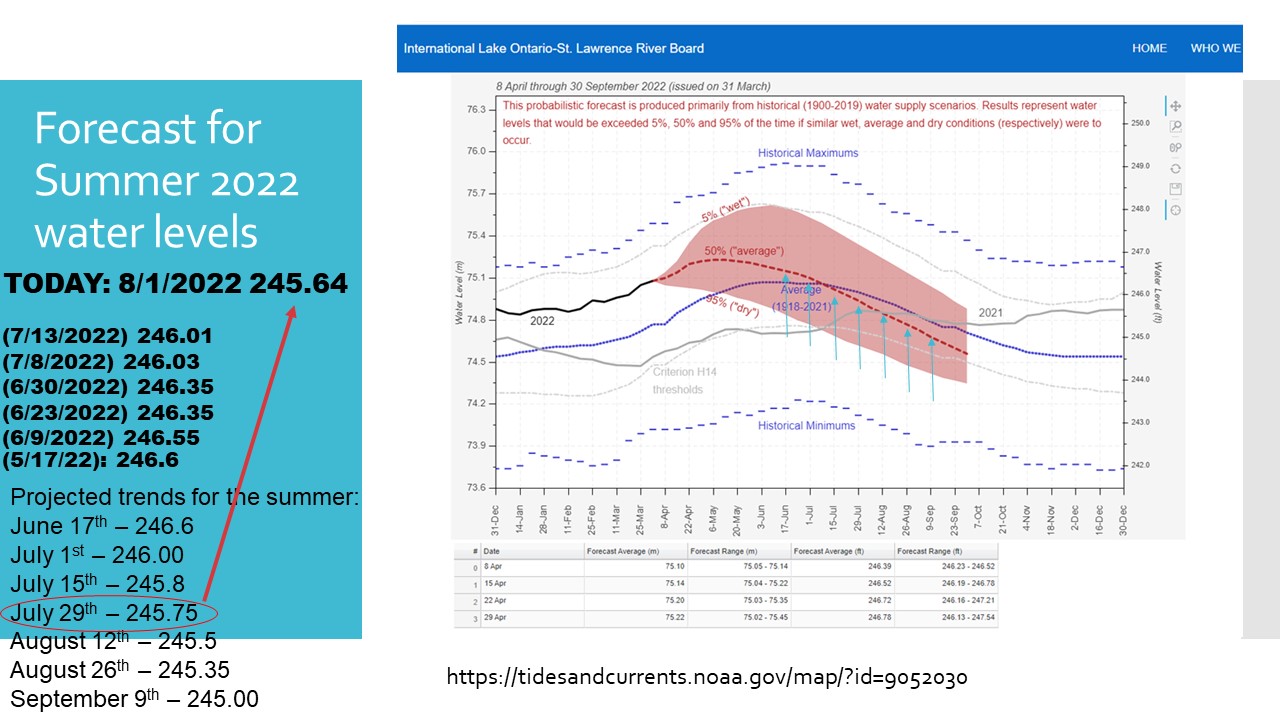
The Water Quality remains pretty stable across the County with variable storm events that help to create more “flow” in the system which causes water movement and introduces more oxygen thus helping keep balance in the system with weed growth, fish & wildlife heartiness and algal blooms. As far as water levels go, Lake Ontario predictions are pretty close to date. Upland streams and tributaries need to remain clear. If there are log jams that completely cross a stream system this can cause other flooding problems during storm events. Try and work out how to remove it by lopping it up or sliding it over to the bank. However, some limbs or tree top branches in the stream create habitat for wildlife, help keep streams cooler and do help in some instances with bank stabilization and erosion.
Need technical assistance? Visit https://waynecountynysoilandwater.org/request-assistance/
Have a question specific question? Email Lindsey@WayneNYswcd.org or Maxine@WayneNYswcd.org
Free Seedlings Available to Qualified Landowners
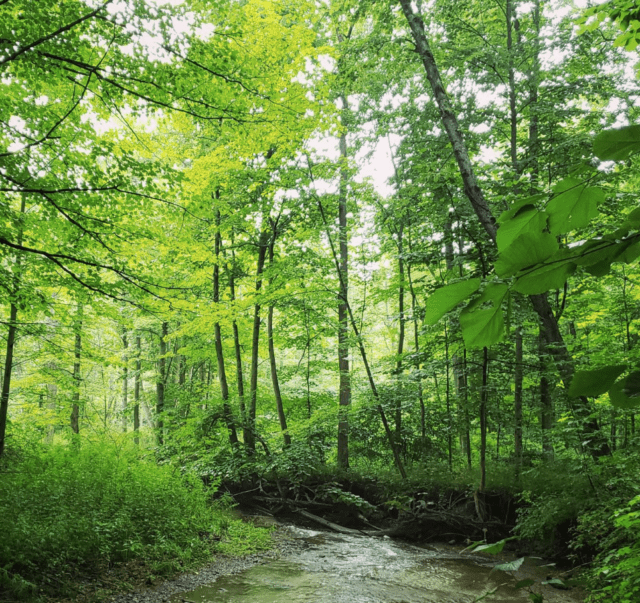
Photo Courtesy NYS DEC
NYSDEC recently announced that the application period for the ‘Trees for Tribs’ “Buffer in a Bag” Program is now open. Qualifying private and public landowners may apply for a free bag of 25 tree and shrub seedlings for planting near streams, rivers, or lakes to help stabilize banks, protect water quality, and improve wildlife habitat.
DEC’s Trees for Tribs Buffer in a Bag program provides free tree and shrub seedlings for organizations and private landowners to create or improve stream buffers on their property. The seedlings are available to qualified landowners for streamside plantings under DEC Buffer in a Bag Program Learn more at https://www.dec.ny.gov/animals/77710.html#Bag
Riparian buffers are strips of vegetation (trees, shrubs or grass) planted next to streams or other waterbodies. By planting vegetation along streams, space is created between the water and upland land uses, which helps protect the water quality and stream habitat. To qualify, landowners must have property in New York State with at least 50 feet bordering a stream, river, or lake, and provide photos or a map of the planting location.
Previous recipients are encouraged to reapply to continue to build riparian buffers. Applicants are eligible for one bag of 25 seedlings and recipients are chosen on a first-come, first-served basis. A total of 350 bags will be available statewide for this round of applications. The 2023 Buffer in a Bag program, application requirements, and the April 7 deadline. Applications are due by 3 p.m.
These mighty waterside plants start out small, but their impacts are huge:
🌱 They help reduce pollution from entering waterways
🌱 They absorb rain during storms, which slows flooding
🌱 Their roots hold soil in place, which prevents erosion
🌱 The provide wildlife habitat both on land and in the water
🌱 They provide shade, which cools water temperatures and protects native fish
🌱 They absorb and store carbon dioxide, which helps combat climate change
Contact treesfortribs@dec.ny.gov with questions and visit DEC’s Trees for Tribs webpage to learn more.
Climate Resilient Farming Grant Program
$28.5M will be provided through the Climate Resilient Farming Grant Program and the Agricultural Non-Point Source Abatement and Control Program
Climate Resilient Farming Grant Program helps farms reduce their operational impact on the environment and address the impacts of extreme weather events resulting from climate change. This is Round 7. The program offers $15 million and up from $8 million in the last round of the program. The program is designed to help farmers implement agricultural projects and make related equipment purchases that reduce greenhouse gas emissions, and support soil health and improved water quality. Projects will also help agricultural producers prepare for and better manage impacts of climate change, including increased heavy storm events, overall rainfall, and periods of drought.
According to NYS Ag and Markets, this year’s program emphasizes precision feed management and agroforestry, two best management practices that are identified in the New York State Climate Action Council’s Scoping Plan as critical to helping increase carbon sequestration and reduce greenhouse gases on farm.
The Climate Resilient Farming Grant program eligibility has also been expanded by updating the definition of a farm operation to include urban agriculture and non-traditional operations. Urban agriculture is an increasingly important focus area for the Department as it continues its work to grow a more resilient food supply system. In addition, new and beginning farmers are being prioritized for this funding opportunity.
For more information, and to see if you qualify contact Ian or Ron at 315-946-7200
Water Quality Update 07-28-2023
Water Quality Update 07-28-2023 – FAQ
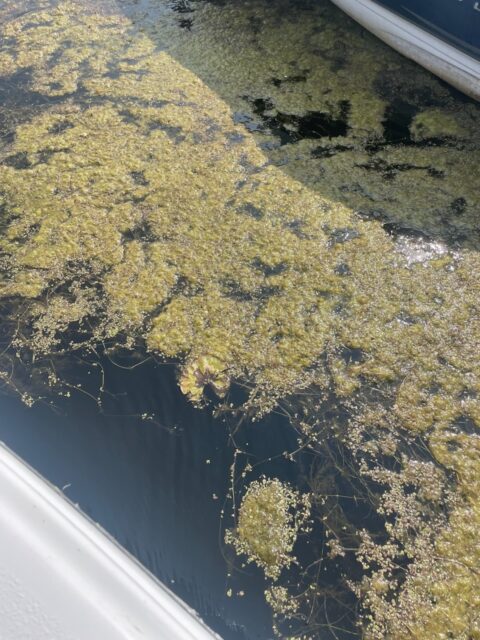
Although duckweed can cover the water surface, it is not algae, and does not produce harmful toxins.
1. Why are weed and algae conditions so frequent this year?
Weed growth in 2023 is in direct correlation from early season water temperatures which began growth early. The fast and random nature of the storm systems rolling through, keep causing flushes from the tributary streams. Nutrients from these streams are moving into the bay which is causing stronger weed beds in general and with the clarity of the water more dense growth is occurring. Weeds, many of the Bay viewers are seeing, include many natives and invasive species combined this year. Surprisingly, earlier in the season, regular milfoil, elodea and eel grass. This past week, the bay turned over which caused a mixing of the water columns. Think of “shaking the Italian dressing bottle.” The previously individualize water columns have now been blended which forced many of the weeds to reach maturity and die. This causes a release of nutrients back into the water, which causes algae to grow and die and then float to the top. Currently, the “nutrient plops = algae” is mixing with break off and floating duckweed.
Certain areas of the bays that are shallower and restricted in water movement do have potential for Cyanobacterial blooms aka Blue/Green Algae.
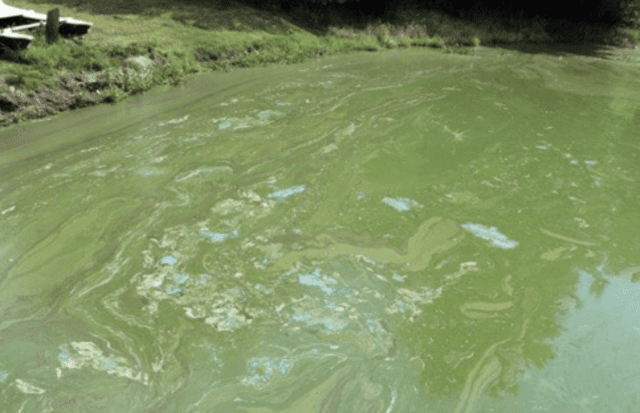
Cyanobacterial Blooms
How can you help? Run a boat slowly through the area to introduce oxygen and mix the water columns. Oxygen keeps these bacterial strains from growing and multiplying.
2. Are the weeds and striated algal harmful to animals or humans?
The weeds them self and algae that is currently present in many of the areas in Sodus Bay, are not harmful to animals or humans in the nature of medical concerns.
Cyanobacterial Blooms are, if you begin to have an area that looks like a paint spill on the water, do not go in the water or allow animals too. Slowly move the water with a boat or bubbler to introduce oxygen and mitigate growth of the impacted area. https://www.dec.ny.gov/chemical/77118.html
3. How can people get rid of the weeds gathering along their docks and crowding their shorelines?
Short term response to mitigate the algae and weeds from becoming a long term cycle of nutrients from dying plants becoming food for new growth, removal is the best option. Pull a small amount onto your dock to dry in the sun, then scoop up and apply to flowers or vegetables. Weeds dry down about 90% and are full of nitrogen. Weeds do not grow well in areas were there is moving water. Regular movement of water and increased oxygen has a lot of benefits. It will reduce strong weed growth, draw fish and other in water wildlife to eat the weeds. The oxygen will also mitigate algal growth.
Other things that will mitigate weed growth in your immediate waterfront is how you care for your lawn. Please see Homeowners guide for additional details on strategies: Homeowners Guide for Shoreline Property Owners
Great Lakes Action Agenda Public Meeting
The New York State Department of Environmental Conservation (DEC) is holding a series of regional workgroup meetings to engage with the public about New York’s Great Lakes Action Agenda 2023 (GLAA) (PDF). The workgroups will assist in the implementation of the action plan to guide restoration and conservation and foster sustainable, resilient communities across New York’s Great Lakes region.
Announced in July 2023, the Action Agenda is a strategic ecosystem-based action plan to guide restoration and conservation and help communities in New York’s Great Lakes Basin better prepare for flooding and severe weather events driven by climate change. Building on the foundation of the first GLAA released in 2014, the updated plan provides a shared vision and blueprint for achieving healthy Great Lakes lands and waters through coordinated, collective action by the many federal, state, and local partner organizations working throughout the watershed.
The upcoming southeastern workgroup meeting will be held:
Southeast Lake Ontario:
Nov. 29, 1 – 4 p.m. – McCrobie Civic Center, 21 Lake St., Oswego
Cover cropping, Irrigation system management and the promotion of pollinator habitat.
The District is pleased to announce funding to help with cover cropping, Irrigation system management and the promotion of pollinator habitat.
